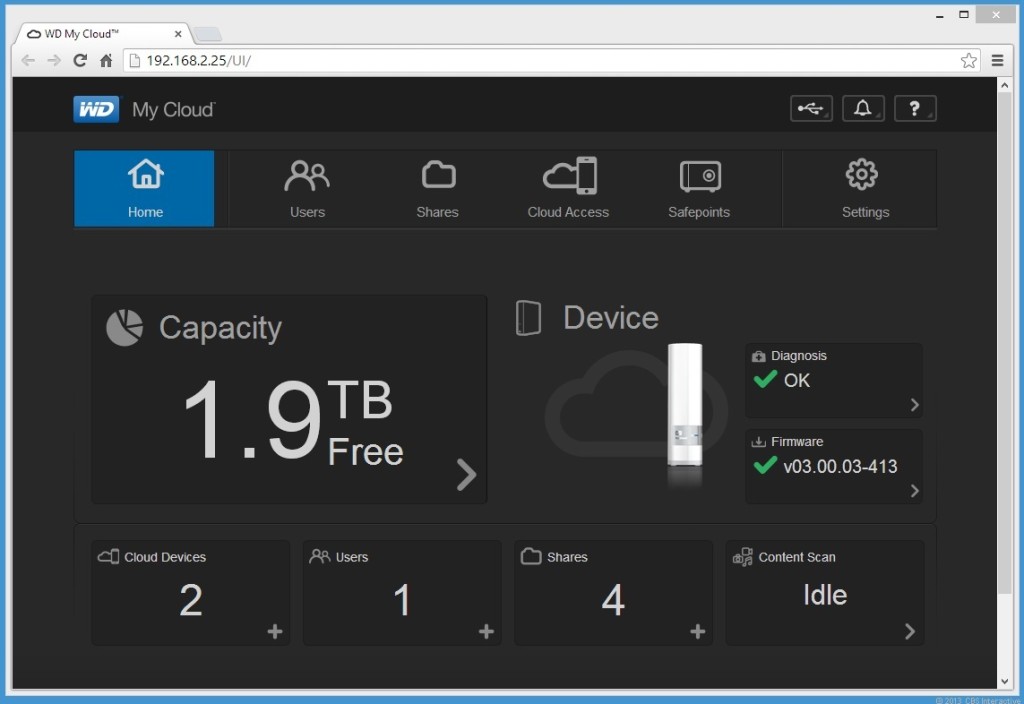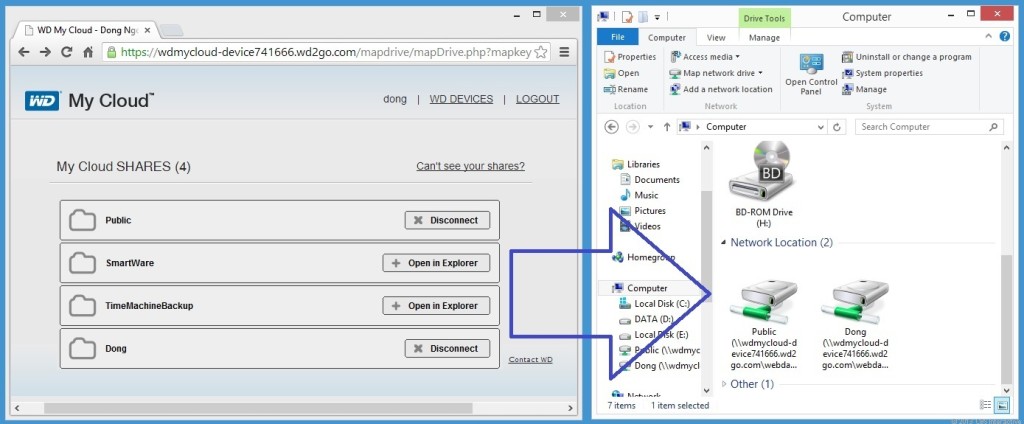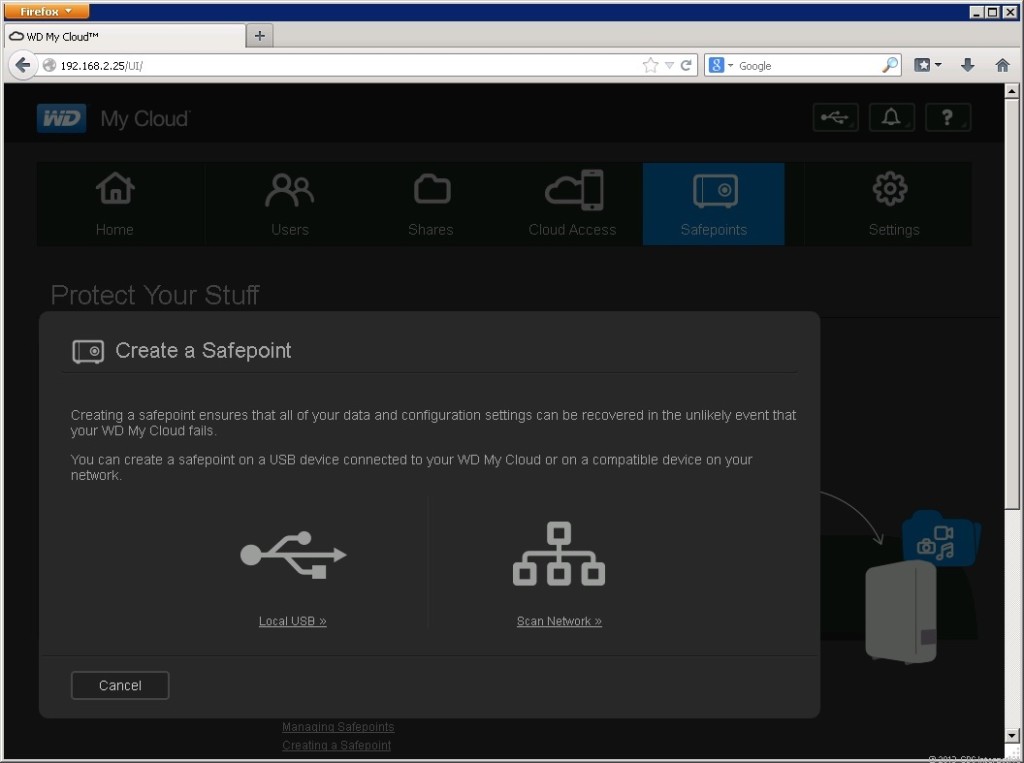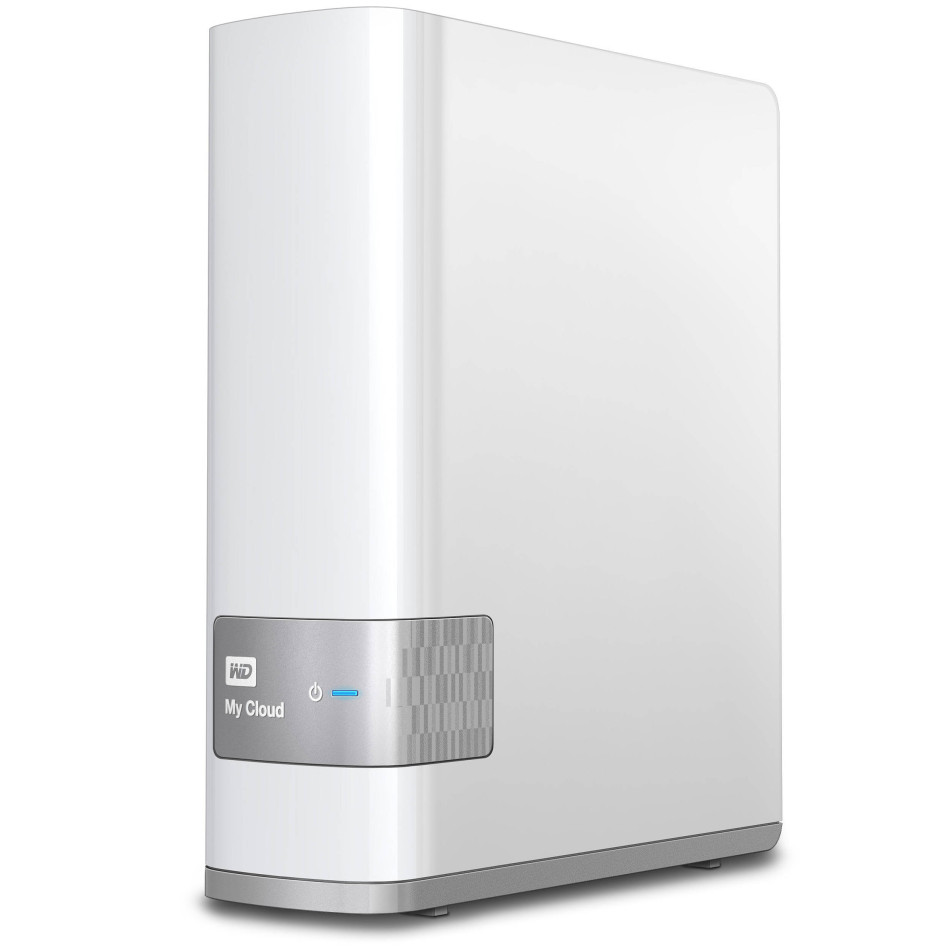Everyone’s talking about “the cloud” these days, and cloud sync and storage solutions are pretty awesome. Services like Dropbox and iCloud make your life so much easier, but how secure are they? Do you really want to trust your private photos and sensitive personal data to some company that constantly has hundreds of hackers looking for new ways to breach its services? Here’s another option: Use the WD 4TB My Cloud Personal Network Attached Storage solution to set up your own personal cloud server in minutes, right in your own home.
Here are some product highlights:
- 4TB Storage Capacity, Back up files from all your computers
- Gigabit Ethernet and USB 3.0, Blazing-fast file transfers
- Package Includes: Personal cloud storage, Ethernet cable, AC adapter and Quick Install Guide, DLNA 1.5 and UPnP Certified
- Auto Network Discovery
- Windows and Mac Compatible
- Stream to your DLNA/UPnP-certified connected TVs, media players and gaming consoles
e WD My Cloud is Western Digital’s answer to the Seagate Central, which came out five months ago. The new network-attached storage server was worth the wait, however, offering by far the fastest speed among its peers and a host of useful features, while costing about the same as its Seagate counterpart.
Unlike the underwhelming My Book Live it replaces, the WD My Cloud is among the best in its class and the first from WD that includes an excellent personal cloud function. It also has a USB 3.0 port for storage extension or backing up data.
If you’re looking for a fast, easy-to-use NAS server for your home, at the suggested cost of just $150 for 2TB ($180 for 3TB, and $250 for 4TB), the WD My Cloud is an excellent choice among single-volume network storage devices. For more NAS server options, including those with multiple volumes, check out this list.
Compact and familiar design
The My Cloud looks very similar to previous WD home NAS servers, taking the shape of a book standing on edge. This is a single-volume storage device that houses one 3.5-inch hard drive, which, like the WD My Book Live’s, is not user-serviceable. The device is very compact, just slightly larger than a standard desktop internal hard drive.
On the front the device has one blue LED status light that stays solid when it’s powered up and flashing when there is data activity. On the back are a Gigabit Ethernet port, a USB 3.0 port, and the power connection port. The My Cloud comes with a small power adapter, a network cable, and a Quick Setup guide. You won’t need much help with the setup process, however.

The My Cloud’s Dashboard Web interface is very well-organized and should be easy to figure out even for a novice user.
Setup is a breeze
The My Cloud is by far the easiest NAS server to set up that I’ve encountered; you literally just need to connect it to the power, hook its network port to a router (or a switch), and you’re done.
By default, the server comes with three public share folders called Public, SmartWare, and Time Machine Backup. As the names suggest, the Public folder is for storing public data, and the other two are for backups of Windows and Mac machines, respectively.
As soon as the device is plugged in, all of these public folders are available to all connected devices in the home network. From a Windows computer, you can browse for these share folders and copy data (such as digital content) over. Macs will immediately see the My Cloud as an available destination for Time Machine backup and the My Cloud will also appear on Finder. All DLNA-enabled network media player devices, such as the WD TV, will also immediately find the content stored on the My Cloud for streaming purposes.
And that’s not all: if you download the My Cloud mobile app (available for iOS and Android), the app will see the My Cloud and connect to it as long as the mobile device and the My Cloud belong to the same local network. The interesting part is, after this first step, now even when you’re out and about, connecting to a different Wi-Fi network or using a cellular connection, the mobile app on your device still maintains access to the My Cloud NAS server via the Internet. (More on this app below.) In other word, there’s no extra setup or log-in needed to make the app work with the server remotely.
So if you use the My Cloud by yourself or share it with a group of people with no need for data privacy among themselves, there’s really nothing to setting up the My Cloud, other than plugging it in and downloading the mobile app. Now, if you want to further customize the NAS server, that’s also quite easy to do. In this case you will need to first download the WD My Cloud Setup software from WD2Go.com and install it on a connected computer, whether Windows or Mac.
Advanced, yet not overwhelming personal cloud features
The WD My Cloud comes with a handful of desktop software and mobile apps to enhance the user experience. They are all very self-explanatory and useful. Except for the WD SmartWare backup program, which is only available for Windows (since Macs already have Time Machine), the rest of the software is available for both platforms. In this review I will talk only about the Setup desktop software and the My Cloud mobile app.
When I tried it, the Setup software quickly found the My Cloud and asked me to create the first user account. This account will have admin privileges and you can use it to log in to create more accounts. Once each account is created there will be a new private share folder named after the account holder. This private share folder is only available to that user and nobody else. After that, the software will create desktop shortcuts to the server’s public share and for its Dashboard Web interface. This interface provides access to all of the server’s settings and features.
The interface is well-organized, with six tabs on top for Home, Users, Shares, Cloud Access, Safepoints, and Settings that take you to more customizations.
The most interesting tab is Cloud Access, which allows you to sign up for a WDMyCloud.com online account for each user account of the NAS server, and to create an access code for the mobile device app. These are both powerful features.

With an account with WDMyCloud.com, you can quickly create a mapped network drive to share folders from the My Cloud on a computer as though the two belonged to the same local network.
The online account with WDMyCloud.com basically allows a VPN-like connection over the Internet for computer users. For example, when you’re traveling away from home, even in a different country, then from a computer connected to the Internet you can point the browser to WDMyCloud.com and log in with the WDMyCloud account, and with a click you can quickly create a network drive linked to a share folder on the My Cloud NAS server at home. This means you can just drag and drop files between the computer and the server as though the two were on the same local network. This is similar to VPN access though there’s no VPN connection. (Note that the speed of data moving between the remote computer and the NAS server depends on the speed of the Internet at both the computer’ and the server end.) You can also quickly disconnect the mapped network drive when you want to disconnect the remote computer from the server.
The access code for mobile devices would be useful if, for example, you want your friend who lives in a different city to be able to share data with you via the My Cloud. Just create a user account for that person on the NAS server, create an access code, and give the information to him or her. Your friend then can download the My Cloud mobile app, run it, and enter the code. Now he or she can use the My Cloud without ever having to be anywhere near the server, physically.
In all, this is by far the easiest system I’ve seen for remote access among all the NAS servers I’ve reviewed. It was actually much easier to do than explain.
Excellent app for mobile backup, but limited for streaming
WD’s My Cloud mobile app is very similar to Seagate’s Media mobile app for the Seagate Central. With this app, you can access the public share folders as well as the private share folder of the current user. You can quickly download files from the NAS server to the mobile device or back up files, such as photos and videos, from the mobile device onto the NAS server. You can do more than one of these tasks at the same time, making it an excellent backup server for those who love taking photos and video with their phones.
Unfortunately, unlike the Seagate Media app, which can organize digital content into categories (Documents, Videos, Photos, Music), the My Cloud App only supports browsing by folders and subfolders. This is fine for videos but for music and photos, it’s such a pain, especially when there’s no built-in search functionality. On top of that, while you can easily dig deeper into subfolders, there’s no “back button” way to go back to the previous level of folder browsing, making it quite awkward for viewing content.
The support for media streaming is also extremely limited: you can basically play back only the types of content natively supported by the mobile device. And only music can really be streamed; other content needs to be first buffered (temporarily downloaded) onto the mobile device before it can be played back. For example, if you want to view a photo that resides on the My Cloud NAS server using an iPad, the mobile app would first buffer the entire photo onto the mobile device before displaying it. This makes viewing even a small photo take quite a bit of time and makes it virtually impossible to stream video over a cellular connection.
That said, though the app is very responsive and easy to use, for now it works best as a way to back up content from a mobile device to the My Cloud NAS server, rather than the other way around. Note that I tested the My Cloud and its apps prior to their launch, and things can be better in the final version of a product.

The power to create restore points helps the My Cloud overcome the data safety shortcomings of a single-volume NAS server.
No data redundancy but excellent backup feature
As a single-volume NAS server, the My Cloud has no real-time mechanism guarding it against the failure of the internal hard drive. To make up for this, you can easily back up its contents using the Safepoints feature. This creates a restore point for the server by copying its entire contents onto an external hard drive connected to its USB 3.0 port or to another My Cloud unit. When something happens, you can restore the server. This worked well but make sure you use an external hard drive (or a second unit) that has at least the same capacity as the server. WD says that in the near future, it will also release a new version of the My Cloud that comes with more than one internal hard drive on the inside to support RAID configurations.
Top-of-class performance
The most impressive thing about the WD My Cloud is its performance. For the first time a single-volume NAS server offers a data rate rivaling that of more advanced, multiple-volume servers. In my testing, over a Gigabit Ethernet connection, the server offered a sustained speed of 67MBps for writing and 87MBps for reading, both being significantly faster than any of its peers.
Conclusion
In the My Cloud, WD has combined data sharing, media streaming, backups, and a powerful personal cloud feature in a single compact box that everybody can use. On top of that, for the first time, home users can really expect from an affordable device the data speeds of a much more expensive NAS server.
The device’s only shortcoming is its mobile app, which could use some improvement, and I have no doubt that will happen via updates. And even at its current stage, with a price tag of just $250 for the top capacity of 4TB, the My Cloud is a steal.








